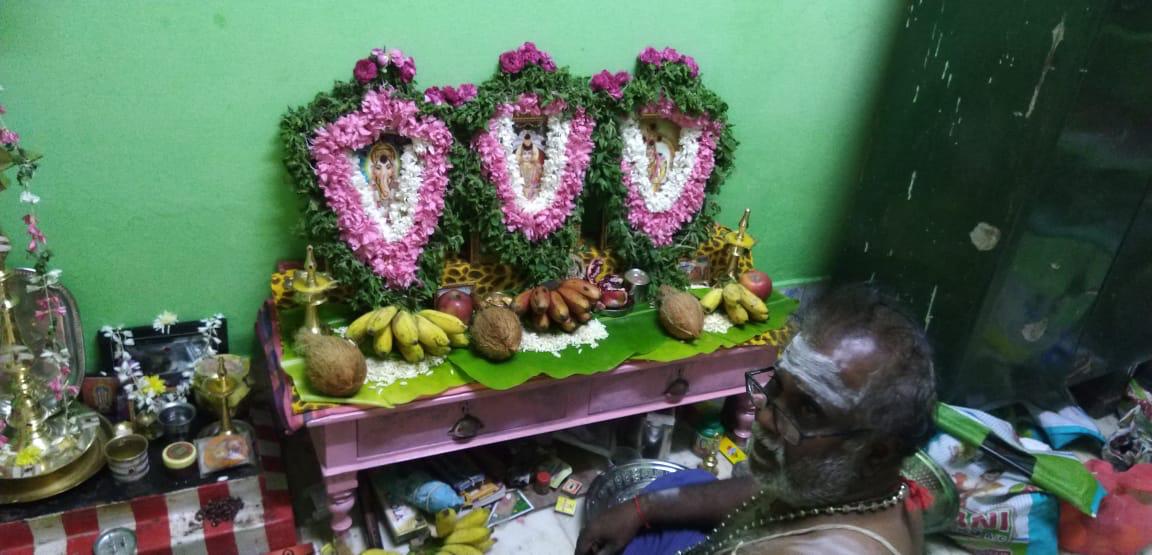A Sacred Space at Home: The Significance of a Personal Altar in a Sattvic Lifestyle
A personal altar is a cornerstone of the sattvic lifestyle, offering a sacred and serene space to anchor spiritual practices and align daily living with cosmic rhythms. In the Hindu tradition, every action, no matter how mundane, is an opportunity to invite divinity into our lives. From drawing kolams at dawn to preparing sattvic food, these practices are more than cultural rituals; they are pathways to connect with universal consciousness.
Last week, we explored the significance of kolams—sacred geometric floor drawings symbolizing welcome and protection. In our other blog posts, we’ve delved into sattvic foods and how lifestyle choices rooted in clarity, calmness, and compassion can uplift the body, mind, and soul. This post builds upon that foundation by offering insight into one of the most powerful elements of a sattvic home: the personal altar.
Why Create a Sacred Space?
The concept of an altar goes far beyond a place to light incense or display pictures of deities. It is a spiritual energy center that acts as a bridge between the material and the divine. In ancient Hindu philosophy, the altar is a microcosm of the cosmic temple. It becomes a site of daily devotion, inner reflection, and conscious alignment with higher energies.
Our ancestors—the ancient rishis and sages—lived in deep awareness of the rhythms of the universe. They practiced techniques to attune their consciousness with celestial movements, moon cycles, planetary shifts, and solar transitions. Their consistent message to humanity has always been clear: when you align your inner life with cosmic events, the energy field around you shifts, bringing blessings, insight, and abundance.
In a world filled with distractions and challenges, an altar reminds us that we, too, are on a cosmic journey. It invites us to rise above the fluctuations of daily stress and step into a higher awareness.
The Temple at Home
Hindus around the world traditionally maintain a dedicated space—a personal temple within their home. Whether large or small, this altar is a sacred zone where cosmic energies are welcomed, worshipped, and celebrated. While public temples are rich sources of consecrated energy, the home altar functions as a personal power center where spiritual connections can be deepened every day.
Even a simple shelf, corner, or cabinet space can serve as an altar. The size or grandeur is not as important as the intention and energy poured into it. When you offer sincere prayers, chant mantras, or spend time in silence before the altar, the energy accumulates and amplifies. Over time, the altar becomes a living spiritual presence in your home.
Some choose to create elaborate spaces with carved wooden doors, idols made of brass or stone, decorative garlands, and sacred symbols. Others may simply dedicate a table in the living room or a niche in the kitchen for this purpose. Regardless of the setup, the altar becomes a spiritual heartbeat of the home.
Building and Sustaining Energy at the Altar
One of the most powerful ways to energize your altar is through sound and vibration. Daily chanting, playing of sacred mantras, or singing devotional songs help to boost the energy field of the altar. These sounds attract positive cosmic frequencies and elevate the vibration of the entire space. Over time, your altar transforms into a receptor and transmitter of divine energy.
When deities are energized, they become dynamic forces that respond to the devotee’s intentions. Those who connect with the altar regularly often report moments of clarity, healing, or unexpected support during tough times. It is believed that working with such a higher consciousness also helps reduce karmic burdens and brings peace to generational lines.
How Often Should You Worship?
The frequency of worship can vary depending on personal preference, tradition, and schedule. Some worship daily, while others choose to offer prayers on specific days connected to the deity they revere. For example:
- Devotees of Shiva may worship on Mondays and Pradosham evenings.
- Those devoted to Ganesha or Muruga might focus on Tuesdays and Sankatahara Chaturthi.
- Shakti worshippers often choose Tuesdays, Fridays, and the Navaratri season.
In addition to regular prayers, many people worship during festivals, birthdays, before important journeys, or during periods of illness and healing. There is also the practice of seasonal worship, where the altar is updated to reflect the changing energies of the solstices and equinoxes. (Read more in our seasonal celebrations blog post.)
Worship as a Collective Practice
In many homes, the altar is not only a private sanctuary but also a place of gathering and celebration. Family and friends may join together to sing bhajans, chant sacred texts, or observe traditional rituals. Both men and women actively participate, with women often playing a central role in maintaining the spiritual rhythm of the household.
The altar becomes a space of bonding, nurturing, and collective upliftment—something increasingly rare and deeply needed in today’s fast-paced digital world.
An Inspiring Example
We are honored to showcase the altar of Shri Jyothi Kumar, a devoted practitioner from Rajasthan, India. While his family maintains a large ancestral altar in their village, Jyothi, who lives with roommates, has created a small, heartfelt altar in his personal room. It features an image of Vinayaka gifted by his grandmother, along with a Shiva Lingam and Nandi given by his mother. He worships daily with devotion, while his father maintains a seasonal altar. Watch this short video of his home altars:
Creating Your Own Altar
You, too, can create your sacred space. Your altar can reflect your spiritual path, your favorite deities, your cultural heritage, or your own intuitive choices. Add candles, incense, flowers, or a sacred stone—whatever brings you into alignment.
Here are a few tips to get started:
- Choose a quiet, respectful space.
- Cleanse the area before setting up.
- Add representations of the divine you connect with.
- Offer daily light (diya or candle) and fresh flowers or water.
- Play mantras or meditate at the altar regularly.
- Update it during festivals or seasons to keep the energy flowing.
Final Thoughts
In this fast-moving world, having a personal altar is a reminder to pause, connect, and realign with your true essence. It’s a place where inner wisdom awakens, where the cosmic and personal intertwine, and where transformation gently takes root.
We invite you to share your altar photos, ask questions below, or explore more resources on our blog. May your sacred space bless you with peace, clarity, and creative breakthroughs on your spiritual journey.
Have a blessed and sattvic day.



